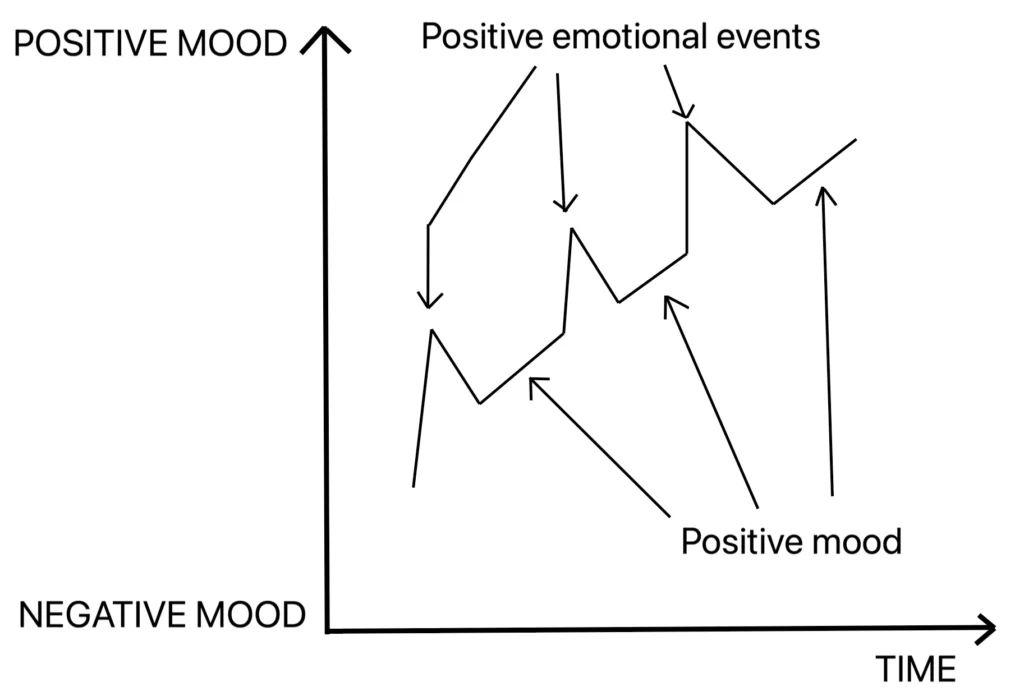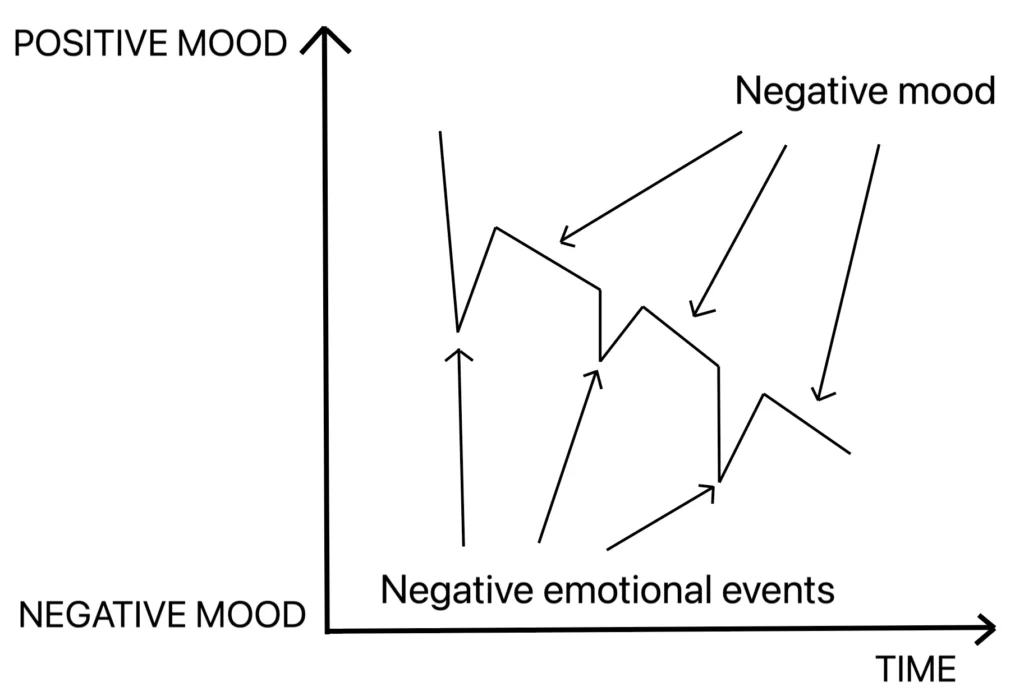Moods are generally low-intensity, long-lasting internal states that are apparently not tied to a clear cause.1Russell, J. A. (2003). Core affect and the psychological construction of emotion. Psychological review, 110(1), 145. They’re typically not intense enough to motivate a person to take action. In contrast, emotions tend to be high-intensity, short-duration states that often have a clear cause. They’re powerful in motivating a person to take action.
Mood can be thought of as a type of emotion.2DeLancey, C. (2006). Basic moods. Philosophical Psychology, 19(4), 527-538. For many moods, when they cross a certain threshold of intensity, they become emotions. For example, you could be in an anxious mood, which can become anxiety. You could be in a depressed mood,d which can lead to depression.

Moods reflect changes in an individual’s internal state. Like emotions, they’re signals that something has changed in our external or internal environment. Specifically, moods function to alert us about changes in the recent state of the external environment and our current physical condition.3Nettle, D., & Bateson, M. (2012). The evolutionary origins of mood and its disorders. Current Biology, 22(17), R712-R721.
Why do we need to be alerted?
Well, changes in these environments inform our decision-making regarding maximizing survival and reproduction. If we were not alerted in this way, our survival and reproductive success would be endangered because we’d be blind to the opportunities and threats in our environment.4Nesse, R. M., & Ellsworth, P. C. (2009). Evolution, emotions, and emotional disorders. American psychologist, 64(2), 129.
For example, when you’re hungry, it signals your body is running out of energy. When you have low energy, you can starve and die. Low energy also means you can’t do other survival and reproduction-enhancing activities like defending against predators and looking for potential mates. It’s more or less the same with other emotions and moods.
You feel good when you detect an opportunity in the environment or do something that enhances your survival and reproduction. You experience positive emotions and moods that reinforce your effective behaviors. When you detect a threat in the environment or do something that impedes your survival and reproductive success, you feel bad. You experience negative emotions and moods that motivate you to either punish (stop) your ineffective behaviors or take risks and try new approaches.
Types of moods
It’s helpful to classify moods based on two dimensions: tone and energy. The tone is positive and negative, and the energy is high and low. The following list is not exhaustive but gives you an idea of where the different moods lie on these two spectrums.
1. Positive moods
a. Low energy
- Calm
- Relaxed
- Content
- Peaceful
- Grateful
b. High energy
- Excited
- Joyful
- Thrilled
- Inspired
- Playful
2. Negative moods
a. Low energy
- Depressed
- Tired
- Disappointed
- Annoyed
- Bored
b. High energy
- Anxious
- Overwhelmed
- Panicked
- Irritated
- Frustrated

Upward and downward spirals of mood
You must have noticed that people tend to be either in upward or downward spirals of mood. Meaning they were feeling bad recently, and now they’re feeling worse. Or they were feeling good recently, and now they’re feeling great. Something happens, and the spirals get reversed. Then something happens, and the spirals get reversed again. That’s life. Why does this happen, though?
When you experience an intense emotional event- a reaction to a significant change in your environment- it spills over into your future in the form of mood. If you experience a positive emotion, you’ll be in a positive mood for the foreseeable future. Your perceptual threshold for detecting positive events gets lowered. You’re more likely to interpret neutral events as positive. This puts you into an upward spiral of positive mood.
Simply, it means you’re likely to feel good when you’re already feeling good. Adverse events have to be quite strong to break this upward spiral.
Similarly, if you experience a negative emotion, you’ll be in a negative mood for the foreseeable future. Your perceptual threshold for detecting adverse events gets lowered. You’re more likely to interpret neutral events as negative. This puts you in a downward spiral of negative mood.
Simply, it means you’re likely to feel bad when you’re already feeling bad. Positive events have to be quite strong to break this downward spiral.


Thus, moods can be thought of as spilled-over emotional states. If something bad happens to you, you’ll feel a negative emotion. That emotion is a signal that something is wrong. If you don’t immediately resolve that emotion, it turns into a bad mood and lingers in your psyche. Hence, contrary to popular belief, moods do have causes. For bad moods, the cause is usually unresolved emotional states.
The mind can’t give you a strong negative emotion continuously. Emotions are signals asking you to act now. The mind can’t keep telling you to act now forever. That way, the problem causing the emotion would consume your cognitive bandwidth. Since the environment keeps changing and you have other opportunities and problems to attend to, you can only give limited attention to one problem. So, the intensity gets lowered, and the emotion becomes mood. The screaming becomes whispering. The wind becomes a breeze. It’s still in the background. You can return to it later.
